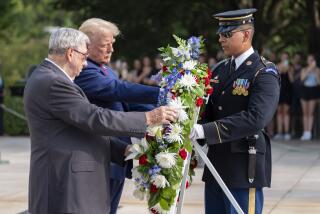Westwood Hills residents want sound wall next to Los Angeles National Cemetery
Whenever he drives past the Los Angeles National Cemetery, Bill Hutton silently reflects on the thousands of precisely placed white grave markers and remembers his own close calls while serving in Vietnam.
He also hears the noise from cars roaring by on the 405 Freeway just feet from Sepulveda Boulevard, which runs along the cemetery’s west side. He finds it perplexing that transportation engineers have not planned a sound wall as part of the ongoing freeway-widening project.
“National cemeteries are sacred to our vets who have given so much for our country,” said Hutton, 63, of Thousand Oaks, the thrice-wounded national senior vice commander for the Military Order of the Purple Heart. “When I go by this area and see the close proximity of gravesites to this freeway, it’s bothersome.”
Hutton supports a campaign by residents of Westwood Hills, a neighborhood north of the burial grounds, who have submitted a petition to push for a sound wall. They hope that a proposed change in federal traffic noise regulations could bolster their cause, although a state transportation official says a wall is unlikely.
“They’ve torn down trees and vegetation,” said Harry O. Schenk, an attorney who lives just north of the cemetery. Along some portions, he said, the freeway will be less than two feet from Sepulveda.
“It will be four lanes of traffic and then headstones,” Schenk said, with a bit of hyperbole. “For a historical place, that’s unacceptable.”
The National Cemetery Administration, which oversees military burial grounds, has told the Los Angeles County Metropolitan Transportation Authority it does not have an official position on the “local matter” of a sound wall across from the cemetery.
Lynnette D. Parker, who has been director of the 114.5-acre Los Angeles cemetery since November, acknowledged that the freeway widening north of Wilshire Boulevard has caused “some people in this area to be uncomfortable.” But she added that cemetery officials have heard no complaints from visitors about freeway noise.
Her goal, she said, is “to maintain the cemetery as a place of beauty and serenity where loved ones can reflect on the service” of veterans.
The cemetery dates to the late 19th century. According to the U.S. Department of Veterans Affairs, the Pacific Branch of the National Homes for Disabled Volunteer Soldiers — what would become the West Los Angeles Veterans Affairs campus — was established in 1887 on Santa Monica ranch lands donated by Nevada Sen. John P. Jones and Arcadia B. de Baker. In 1890, 20 acres were added for use as a veterans cemetery.
More than 85,000 veterans and family members are buried at the cemetery, which is studded with trees and monuments. Among those interred there are 14 Medal of Honor recipients, 100 Buffalo Soldiers (African Americans who fought in the Civil War), Nicholas P. Earp (father of Wyatt Earp) and two dogs (including Blackout, wounded in the Pacific in World War II).
The site is considered a “closed cemetery,” meaning that the only new interments will be those of spouses of veterans who are already buried there or veterans whose eligible family members are interred there.
The first phase of a new columbarium is expected to open in November 2012 on 14 acres west of the 405 Freeway. That will provide 10,000 niches for cremated remains. Once completed, the columbarium will have between 180,000 and 200,000 niches, Parker said.
“Serenity” in no way describes the construction underway on the freeway side of Sepulveda. As part of the $1-billion project, workers are adding a 10-mile carpool lane through the Sepulveda Pass and rebuilding ramps, bridges and some sound walls. To help reduce noise for residents, an existing 800-foot sound wall that runs south of Montana Avenue will be replaced and extended by 600 feet. That extension will run just opposite the cemetery’s northern end.
But no sound wall is planned along the majority of the grounds. When the project was approved in 2008, noise abatement was not required for burial grounds, said Michael Barbour, who oversees the widening project for the MTA.
The Federal Highway Administration recently determined that a cemetery with frequent “human use” can be considered “noise sensitive” and therefore eligible for noise reduction. That change is expected to go into effect in July, said a Caltrans official, too late for proponents of a cemetery sound wall.
“This is a project that the ship has sailed on,” said Ronald Kosinski, Caltrans’ deputy district director for environmental planning. A sound wall might make residents feel better about effects on the cemetery, Kosinski said, but “we don’t spend hundreds of thousands of dollars just to make people feel good.”
Officials with the California Department of Transportation and the MTA say the additional lane will reduce delays on the north side of the 405 and allow motorists to travel continuously in a carpool lane from Orange County to the San Fernando Valley. The freeway is one of the nation’s busiest.
“I believe in the long run,” Parker said, “this will benefit the VA by helping to relieve traffic congestion in the area.”
More to Read
Sign up for Essential California
The most important California stories and recommendations in your inbox every morning.
You may occasionally receive promotional content from the Los Angeles Times.











